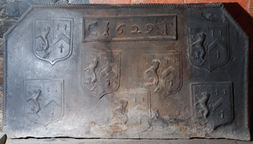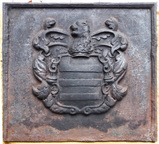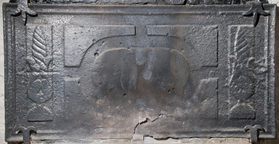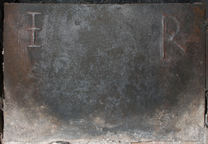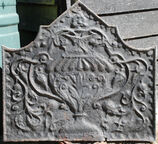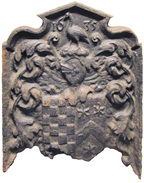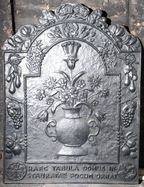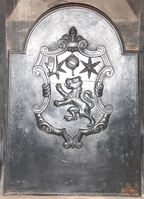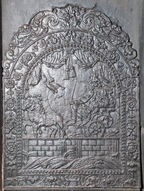-
30
Description: Rectangular, with canted top corners; twisted rope edging on top and sides; cavetto-moulded-edged rectangle top centre, enclosing date between initials; seven shields of Ayloffe impaling Sulyard; Ayloffe: sable, a lion rampant Or, collared gules, between three crosses formy of the second; Sulyard: argent, a chevron gules between three pheons inverted sable.
Notes: William Ayloffe (c.1535-1584) of Bretons, Hornchurch, Essex, Justice of the Court of Queen’s Bench, married (c1560) Jane, dau. of Sir Eustace Sulyard, of Runwell, Essex. A large number of variants use the same shields. The possibility that 'CT' was the founder Charles Tyler (d.1629/30) is reinforced by the fact that Poundsford Farm, Burwash, was owned by his grandson, also Charles, and subsequently by the latter's widow, Mary. The back was first noted at Poundsford in 1869.
Inscription: C 1629 T
Arms: Ayloffe impaling Sulyard (William Ayloffe of Bretons, Hornchurch)
- Decoration tags:
- rectangular with canted top corners (shape)
- rope (edging)
- carved stamps
- individual letters
- individual numbers
- planklines
- armorial
- text
Manufactured: in 1629 possibly at Hawkhurst Furnace in the Weald area of England.
Current location: Poundsford Farm, Burwash, East Sussex, England.
Citation: Gardner, J. S., 1898, 'Iron Casting in the Weald', Archaeologia, 56, 1, pp. 133-164.
Citation: Trower, C. F., 1869, 'Burwash', Sussex Archaeological Collections, 21, p. 113.
- Attached to series:
- Ayloffe series
- Personal armorial firebacks
-
31
Description: Fragment; rectangular plate with series of parallelogrammatic billets arranged across the top; crossed billets in corners
- Decoration tags:
- rectangular (shape)
- none (edging)
- simple stamps
Manufactured: possibly in the Weald area of England.
Current location: in private hands Burwash, East Sussex, England.
- Attached to series:
- Miscellaneous stamp firebacks
-
621
Description: Rectangular; ovolo moulded edging (top and sides); central shield, crest and mantling of the Fuller family. The date, of which the 1 is not visible, is split between the top corners of the shield and about two-thirds of the way down.
Notes: A carved armorial on a plain, edged base board; the arms of the Fullers of Brightling Park, Sussex, are: Argent, three bars and a canton gules; the crest; Out of a ducal coronet Or, a lion’s head argent. The Fullers were iron masters and gun founders in the first half of the 18th century, operating Heathfield furnace, where it is likely that this fireback was cast.
Copies of this fireback are known.
Inscription: [1] 7 / 4 7
Arms: Fuller, of Brightling, Sussex
- Decoration tags:
- rectangular (shape)
- ovolo (edging)
- carved pattern panels
- heraldic
- armorial
- text
Manufactured: in 1747 probably at Heathfield Furnace in the Weald area of England.
Current location: in private hands, Butleigh, Somerset, England.
- Attached to series:
- Ironmasters armorial series
- Personal armorial firebacks
-
1121
Description: Rectangular shape; cavetto-moulded edging; central abstract arrangement in low relief of a horizontally positioned oval surrounded by four separated spandrels forming a rectangular shape over all; at each side, on a raised rectangular field, a stylised bud or cone of helical form, within a calyx above a semi-circular base, one mirroring the other. A deep plankline is evident half way up the left plant.
Notes: An excrescence on the right side may have been caused by iron being poured from a ladle disturbing the casting sand. There are no parallels for this fireback design. The central abstract arrangement may be associated with a formal plan of a garden parterre, the stylised plants continuing that theme.
- Decoration tags:
- rectangular (shape)
- cavetto (edging)
- whole carved pattern
- planklines
- architectural
- plants
- objects
Manufactured: in the early- to mid-17th century in the Weald area of England.
Current location: in private hands, Buxted, East Sussex, England.
- Attached to series:
- Miscellaneous pattern firebacks
- Garden design types
-
221
Description: Rectangular; plain plate; inscription in capitals split between top corners, ‘I’ crossed.
Notes: The letters are likely to have been formed by tracing their shape in the casting sand using a pointed implement.
Inscription: I R
- Decoration tags:
- rectangular (shape)
- none (edging)
- individual letters
- text
Manufactured: in the early-17th century in the Weald area of England.
Current location: in private hands, Buxted, East Sussex, England.
- Attached to series:
- Initials only firebacks
-
1308
Description: Rectangular with cavetto curves rising to corners and a ‘pediment’ top; fillet edging with low-relief, alternate regularly-spaced semi-circles and triangles inside; two-handled flower vase with gadrooned top and symmetrical flower design; trailing vines and flowers issuing from top and descending through handles to base; human face at top; date split by vase base.
Notes: The style of the numerals includes a ‘1’ with hooked serifs.
Inscription: 16 52
- Decoration tags:
- rectangular with canted top corners and triangular arch (shape)
- scalloped fillet (edging)
- whole carved pattern
- pictorial
- text
- plants
- objects
Manufactured: in 1652 in the Weald area of England.
Current location: in private hands, Buxted, East Sussex, England.
- Attached to series:
- Gadrooned vase firebacks
- Hooked '1' series
- Brede group
-
917
Description: Rectangular with detached pediment joined by S-curves; cavetto-moulded edging; shield, helm, bird crest and mantling, with date, 1635, split either side of crest; bottom of casting missing due to corrosion.
Notes: Tentatively identified as the arms of Brooke or Broke of Lapley, Staffordshire (blazon: chequy argent and sable, impaling a chevron between three estoiles); this fireback, or its pattern, have been used as a stamp on another fireback with a later date and initials added separately (see no. 831).
Inscription: 16 35
Arms: poss. Brooke of Staffordshire
- Decoration tags:
- rectangular with detached pediment (shape)
- cavetto (edging)
- whole carved pattern
- armorial
- text
Manufactured: in 1635 in England.
Current location: The Museum of Cambridge, 2/3 Castle Street, Cambridge, Cambridgeshire, England.
(part of the The Museum of Cambridge museum group)
- Attached to series:
- Personal armorial firebacks
-
813
Description: Arched rectangular central panel with bead and fillet edging; two-handled vase with flowers issuing from it, a triple plume of ostrich feathers above, and in the bottom right corner the inscribed inscription, 'CofA' [Charteris of Amisfield]; arched rectangular border with fillet edging; central rose at top of arch with other flowers to each side; successive bunches of pears, grapes and apples descending down each side; inscription (Haec tabula domus instauratae focum ornat) in relief in two rows along the bottom, with circular badges of the National Heritage Memorial Fund to left, and National Trust to right; on top, rope knotted in two loops, each containing half of the date in relief, with descending leaves and flowers on each side.
Notes: This fireback was cast for Martin, Lord Charteris of Amisfield (1913-99), Trustee of the National Heritage Memorial Fund, from a pattern he designed and made, to commemorate the completion of restoration work to Canons Ashby.
Inscription: 1984 / CofA / HAEC TABULA DOMUS IN- / STAURATAE FOCUM ORNAT [this plate adorns the hearth of a restored house]
Manufactured: in 1984 in England.
Current location: Canons Ashby, Canons Ashby, Northamptonshire, England.
Museum number: 494619 (part of the National Trust museum group)
- Attached to series:
- British 'Dutch' style firebacks
- Commemorative firebacks
- Martin Charteris firebacks
-
814
Description: Inclined arched rectangular shape' bevelled fillet edging; cartouche shield of the arms of the baronetcy of Dryden of Canons Ashby.
Arms: Dryden family, probably Sir Henry Edward Leigh Dryden Bt.
- Decoration tags:
- rectangular with round arch (shape)
- bevelled fillet (edging)
- whole carved pattern
- armorial
Manufactured: in the late-19th century in England.
Current location: Canons Ashby, Canons Ashby, Northamptonshire, England.
Museum number: NT/L/CAN/M/78 (part of the National Trust museum group)
- Attached to series:
- Personal armorial firebacks
-
222
Description: Arched rectangular central panel with ‘nutshell’ edging on a broad fillet; crowned figure, holding a sceptre in his right hand, sitting in a chariot drawn to the left by two horses with ostrich feather head-dresses; the whole upon a causeway with pilasters and masonry, and waves beneath; a heron flying to the left; above, swagged drapery with two tassels hanging from the centre; arched rectangular shaped border with fillet edging, symmetrical, flower bunches, descending from a ribbon loop; monogram centre bottom, between plant tendrils; on top, symmetrical scrolled plant tendrils.
Notes: The design is derived from a personification of Europe, one of a set of playing cards entitled 'Jeu de la Géographie', designed by Stefano della Bella (1677); a similarity with Queen Anne may not be coincidental; the flying heron has been copied from a print by Wenceslaus Hollar c.1658.
Copies of this fireback are known.
Inscription: SHR
- Decoration tags:
- 'Dutch' (shape)
- fillet (edging)
- whole carved pattern
- pictorial
- allegorical
- monogram
- text
- animals
- humans
- objects
Manufactured: in the late-17th to early-18th century in England.
Current location: Canons Ashby House, Canons Ashby, Northamptonshire, England.
Museum number: NT/L/CAN/M/79 (part of the National Trust museum group)
- Attached to series:
- SHR series
- British 'Dutch' style firebacks
